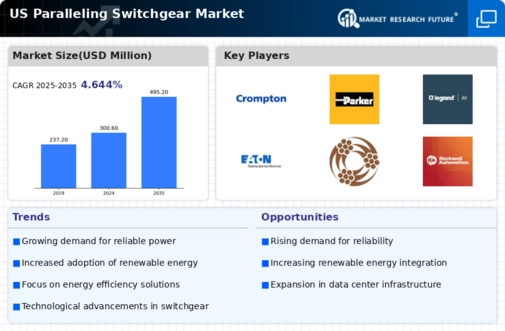Rising Awareness of Energy Efficiency
The growing emphasis on energy efficiency is a notable driver for the paralleling switchgear market. Organizations are increasingly recognizing the importance of reducing energy consumption and operational costs. This awareness is prompting investments in energy-efficient technologies, including advanced switchgear solutions that optimize power distribution. The paralleling switchgear market is likely to see increased demand as businesses seek to enhance their energy management practices. Furthermore, energy efficiency initiatives often align with regulatory requirements, encouraging companies to adopt solutions that minimize waste and improve sustainability. As a result, the market is poised for growth as organizations prioritize energy-efficient power systems.
Growth in Renewable Energy Integration
The shift towards renewable energy sources is significantly influencing the paralleling switchgear market. As the US aims to increase its renewable energy capacity, the need for effective integration of these sources into the existing grid becomes critical. Paralleling switchgear facilitates the connection of renewable energy systems, such as solar and wind, with traditional power sources. This integration is essential for maintaining grid stability and reliability. The US government has set ambitious targets, aiming for 50% of electricity generation from renewables by 2030. Consequently, the paralleling switchgear market is likely to experience substantial growth as utilities and independent power producers invest in technologies that support this transition.
Rising Demand for Reliable Power Supply
The increasing reliance on uninterrupted power supply across various sectors is a primary driver for the paralleling switchgear market. Industries such as healthcare, data centers, and manufacturing require robust power solutions to prevent downtime. The market is projected to grow at a CAGR of approximately 6.5% from 2025 to 2030, reflecting the urgency for reliable power systems. As organizations invest in backup power solutions, paralleling switchgear becomes essential for integrating multiple power sources, ensuring seamless operation. This trend is particularly pronounced in urban areas where power outages can have severe consequences. The paralleling switchgear market is thus positioned to benefit from this heightened demand for reliability, as businesses prioritize investments in advanced power management systems.
Technological Innovations in Power Management
Technological advancements in power management systems are driving the evolution of the paralleling switchgear market. Innovations such as digital monitoring, automation, and smart grid technologies enhance the efficiency and reliability of power distribution. These advancements allow for real-time data analysis and improved decision-making, which are crucial for managing multiple power sources effectively. The paralleling switchgear market is likely to benefit from these innovations, as they enable operators to optimize performance and reduce operational costs. As industries increasingly adopt smart technologies, the demand for sophisticated paralleling switchgear solutions is expected to grow, reflecting a shift towards more intelligent energy management.
Increased Investment in Infrastructure Development
The ongoing investment in infrastructure development across the US is a significant driver for the paralleling switchgear market. With the government allocating substantial funds for upgrading electrical grids and expanding power generation facilities, the demand for advanced switchgear solutions is expected to rise. The Infrastructure Investment and Jobs Act has earmarked approximately $1.2 trillion for various infrastructure projects, which includes enhancements to the energy sector. This influx of capital is likely to stimulate the paralleling switchgear market, as new installations and retrofitting of existing systems become necessary to meet modern energy demands. The focus on resilient infrastructure will further propel the adoption of paralleling switchgear solutions.

















Leave a Comment